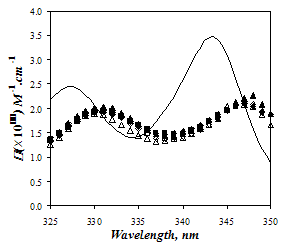

46292-AC7
Complete Characterization of Solutions of Associative Thickeners by Using a Combination of Fluorescence and Rheology Experiments
Progress Report
The project aims at using pyrene-labeled water-soluble polymers (Py-WSP) as associative thickener (AT) mimics to better understand the rheological behavior of AT solutions by monitoring the fluorescence response of the chromophore pyrene while the Py-WSP solution is under shear. AT are water-soluble polymers bearing hydropbobes that aggregate in aqueous solution inducing the formation of an AT network held together via the aggregated hydrophobes. Since the hydrophobes are held together via weak physical forces, the aggregates can be disturbed by application of a shear which results in a weaker AT network and a marked decrease in viscosity. Pyrene is a hydrophobic chromophore that emits at 375 nm and at 480 nm when present in the solution as a monomer or a pyrene aggregate, respectively. The emission arising from pyrene aggregates is that of an excimer. Py-WSP are ideally suited to probe the level of aggregation between pyrene hydrophobes as the Py-WSP solution is being sheared by monitoring the fluorescence response of the solution at 375 nm and 480 nm.
Over the past year, PRF funding has enabled the hiring of four graduate students. Steve (Shaohua) Chen was hired in September 2007 and is preparing monodisperse polyethylenes labeled at both ends with pyrene (Py2PEO) to characterize the fluorescence response of the Py2PEO solution under shear. Steve Chen had little background in organic synthesis and he has worked hard toward acquiring the synthetic skills he needed to prepare his samples. He has already synthesized a few Py2PEO samples and their fluorescence properties are under investigation.
Howard Siu is a more senior graduate student who had already obtained his M. Sc. using fluorescence to characterize pyrene-labeled Hydophobically modified Alkali Swellable Emulsion copolymers (Py-HASE). Over the past year, he has completed the experimental set-up that enables him to study by steady-state and time-resolved fluorescence the Py-HASE solution under shear (see Figure 1). The sample is irradiated via a set of two optical fibers that are carrying photons from the lamp of the steady-state fluorometer and the light emitting diode (LED) of the time-resolved fluorometer through a quartz plate which is used to shear the Py-WSP solution. The fluorescence photons are then collected by a set of two optical fibers and carried back to the steady-state and time-resolved fluorometers to acquire the fluorescence spectra and decays, respectively. To reduce the background level generated by room light, Howard Siu has build a housing that encloses the entire rheometer together with the optical fibers and their holders (see Figure 1). The set-up is now fully operational.
Figure 1: Experimental set up used for irradiating the
quartz plate of the rheometer. Another major accomplishment by Howard Siu was
to determine the molar extinction coefficient of a pyrene aggregate (eagg). The determination of the number of pyrene
pendants that are aggregated in solution can only be done in a quantitative
manner if
eagg is known. Interestingly,
although the pyrene aggregates generated by Py-WSP in water have been the topic
of intense investigation for the past 30 years, eagg was still
unknown before Howard Siu's work. Howard
Siu determined eagg by exciting a Py-WSP solution one nanometer
at a time using a powerful LED. In so
doing, he was able to acquire at a given wavelength the fluorescence decays of
the pyrene monomer and excimer of the Py-WSP solution whose simultaneous analysis
yielded the fraction of the excitation light that had been absorbed by the
pyrene monomer and excimer. Expressing
these fractions as a function of the molar extinction coefficients of the
pyrene monomer and aggregates yielded a set of equations that could be solved
to yield eagg
shown in Figure 2 as a function of wavelength.
Knowing eagg enabled the first ever quantitative determination
of the molar fraction of aggregated pyrenes for the Py-WSP solution under
study. This important result has been
summarized in a manuscript which has been accepted for publication in the J. Phys. Chem.
Golam Moula
was hired in September 2007 to study pyrene-labeled HydroxyEthyl Cellulose
(Py-HEC). Unfortunately he struggled with
his project and after six months, withdrew from the program. There is little to report about his
achievements, since he spent half of his time taking courses and preparing
himself for his Comprehensive Exam, which he decided not to take in the end.
Figure 2: Extinction coefficient of the pyrene monomer
(solid line) and of the ground-state pyrene aggregates (symbols) obtained for 6
different solutions of pyrene-labeled poly(N,N-dimethylacrylamide).
In an interesting development, I
was contacted during summer 2008 by Prof. F. M. Winnik at the Université de
Montréal. Prof. Winnik has prepared a
series of monodisperse poly(N-isopropylacrylamide) end-labeled with
pyrene. These well-characterized
molecules are ideal candidates for the PRF proposal. In September 2008, Jamie Yip was hired as an
M. Sc. student to study them.

